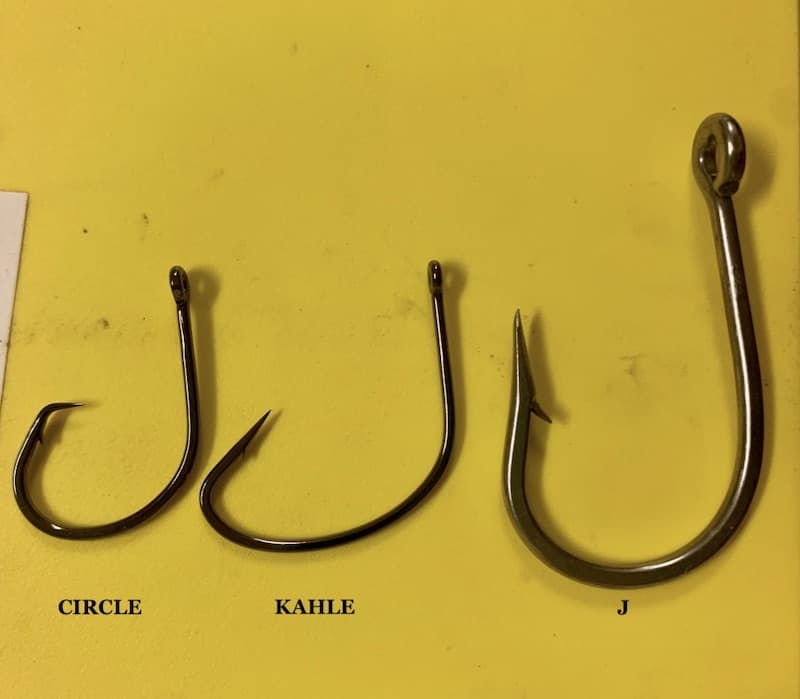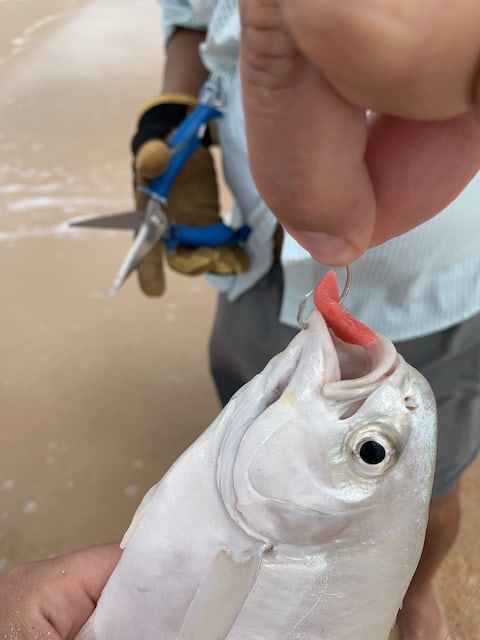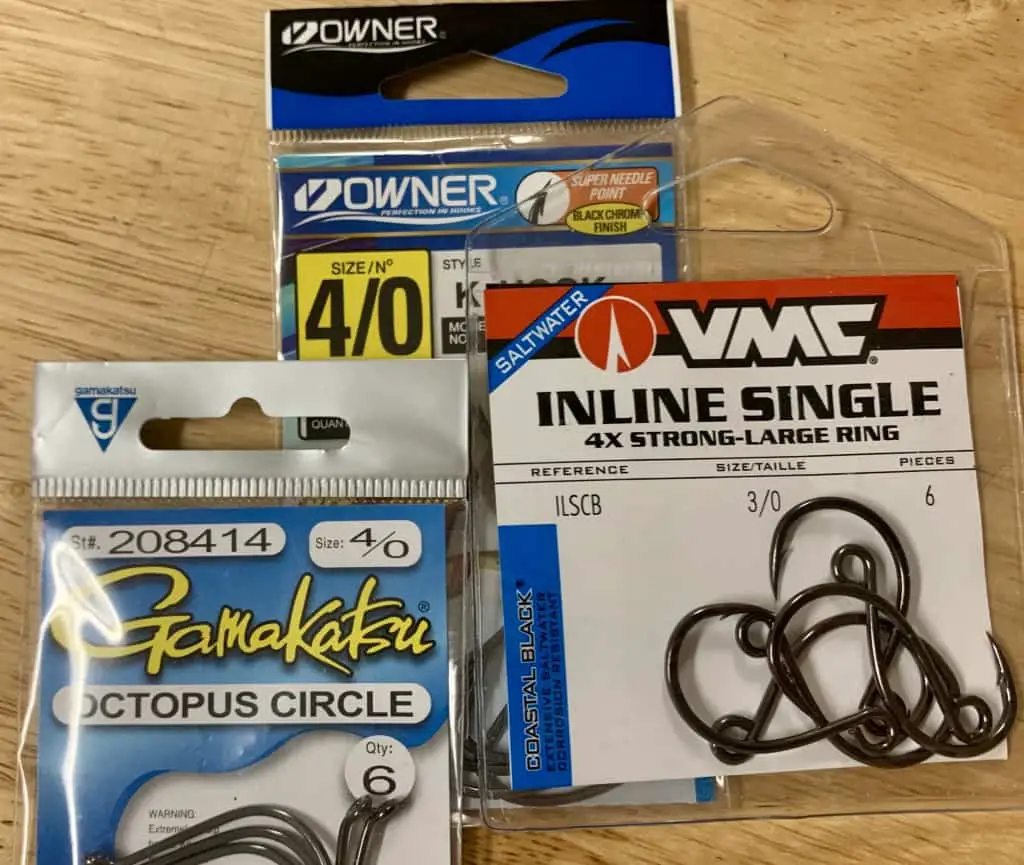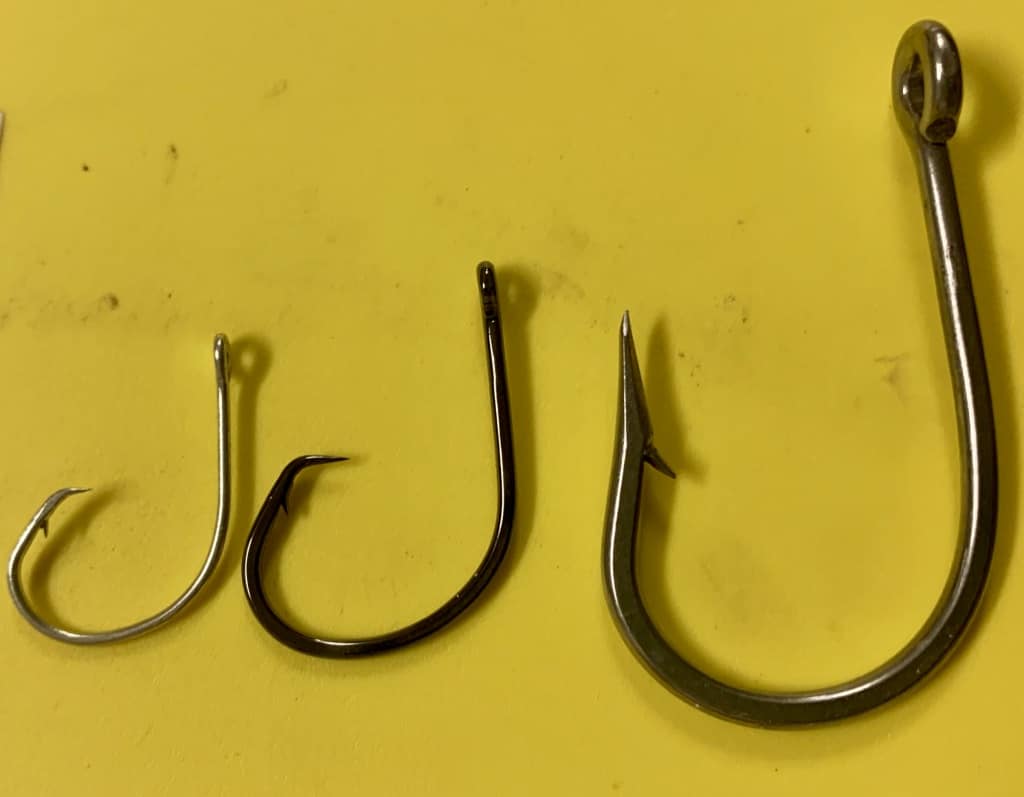What Are the Best Hooks for Surf Fishing?
The best hooks for surf fishing include circle hooks, Kahle hooks, Octopus hooks, J hooks, and treble hooks in sizes 1/0 to 5/0. Circle hooks are best for spiked fishing, Kahle, Octopus, J and treble hooks are better for active fishing. J hooks and treble hooks are best when using artificial lures, and circle, Kahle and Octopus are better for natural baits. For some species, fishing regulations define the hook to use with natural baits, e.g. non-offset circle hook is the legally required hook to use with natural baits when targeting reef fish in Florida. The best size to use depends on the size of your bait and your target species. For small species such as pompano, a 1/0 or 2/0 hook is recommended, and for larger species, such as bluefish or snook, you can go up to about a 5/0. Read on to learn more detail and additional considerations.
How To Tell Which Type of Hook is Best?
When anglers walk through a tackle store, even the most experienced of them can feel overwhelmed by the vast amount of options in the fishing hook aisle. Let's start narrowing down the options by looking at the different types of hooks.
First up is one of the most popular: the circle hook. A circle hook is a unique hook in the sense that it never requires the fisherman to purposefully set the hook. The hook uses the tautness of the line and the fish's movements to hook in the corner of the fish's mouth. A circle hook can be identified by looking at the direction the point points. If it points directly perpendicular to the shaft of the hook, you can be sure its a circle hook.
Circle hooks are best when you're doing passive fishing, aka spiked fishing, from the shore. And due to Florida regulations specifying circle hooks, you'll also want to use circle hooks whenever you're presenting natural bait to reef fish species. This is also the hook to choose when you're doing catch-and-release fishing, specifically the non-offset barbless style. Read more about catch-and-release specifics in our article here: Choosing the Best Hooks for Catch and Release Fishing.
A J hook is another popular choice due to its long history of performance. A J hook has been used for centuries and has only recently become pushed out in some scenarios by conservation-minded anglers. A J hook is highly effective, but it tends to hook anything it touches, so when a fish swallows it, it will likely hook a difficult spot such as the throat, gills, or guts. This is fine for fish you plan to keep, but can result in unintentional loss of life for a fish you plan to throw back. For this reason, J hooks are best when using artificial bait since lures are rarely swallowed. They're also best when doing active fishing as the hook requires the angler to tug on the rod up to set the hook. If you're still stuck trying to decide between a circle hook and a J hook, I'd recommend reading our article that directly compares the two, here: Circle Hook vs J Hook: When Is One Better Than The Other?
The Octopus terminology describes the angle of the hook's eye in relation to the shank. There are octopus circle hooks and octopus J hooks. The most commonly found octopus hooks have an upturned eye, intended to be used on rigs done with a snell knot as the turned eye helps the hook stay in the right position with the tension from the line.
The Kahle hook is a design that falls in between the circle and J hooks. It has the same advantage of a circle hook of most likely resulting in a mouth hook, but attempts to alleviate the difficulty of putting bait on and can satisfy those fishermen who can't break the habit of setting a hook. In comparison to a J hook, the kahle hook has the same advantage of ease of putting bait on, but alleviates the gut hook issue. As with any compromise, a kahle hook attempts to mitigate the disadvantages of two types of hooks, but the result is a hook that underperforms the circle and J hook in their optimum environments. If you'd like to read about kahle hooks vs circle hooks, our article on the topic explains it in detail: Kahle Hook vs Circle Hooks

Treble hooks are also a good choice when surf fishing with an artificial lure. Although this one makes the list, it's our least favorite because of the difficulty of removing treble hooks. Fortunately, there are some smart people out there who came up with the idea of replacing treble hooks on hard plastics with inline J hooks. Reading through our article, Is a Treble Hook Illegal in Florida?, will also help you understand why Florida fishing regulations prohibit the use of trebles with natural bait.
What Size Hook Do I Need?
Now back to perusing the aisle of hooks at the tackle store. Say for example, we know we're going to do passive fishing for pompano. We can figure out that the best hook type would be the circle hook, but how about hook size? The aisle has 1#-12# and 1/0 (pronounced “one ought”) through 10/0. How do you choose the size?
The answer is to choose the size that fits your bait. Normally your bait is sized for your target fish species, so this is a good method of choosing the hook size. For our pompano example, we would choose a 1/0 size if using fish bites, and a 2/0 size if using a sand flea for bait. Our article, Choosing the Right Circle Hook: What Type and Size is Best, includes more considerations for sizing.

Hook Material, Brand, and Gauge
So in our example, we've narrowed it down to a circle hook in size 1/0. Now what about the material, brand, and choosing between fine wire and heavy wire? The material for saltwater is normally a pretty easy choice–stainless steel for optimum corrosion resistance, but be sure to read your local fishing laws, since sometimes stainless is prohibited because corrosion can actually be a good thing to allow the hook to shed from a fish when its returned to the water.
Most fishing hook brands have been around a while, so it would be hard to choose a bad one. Our favorites include Mustad, Gamakatsu, Owner, and Eagle Claw.
You'll also normally see something like “fine wire”, “2X strength”, or “heavy wire” on the packaging. This is regarding the thickness of the hook and the choice here depends on your target species. For strong fighting fish, you'll want heavy wire to avoid the fish straightening out your hook. For a species with a thick mouth that you plan to passively fish for, you'll want a fine wire so it penetrates with just a little tension on your line. Another consideration is whether your bait is live or not. You'll want to opt for heavier wire when using live bait to keep the bait on the hook and to sustain the harder strike. Fish will typically strike dead bait softer so a light wire would be ok for deadbaiting. Next, we'll share a few of our recommendations.

The Mustad Ultrapoint Demon Circle is a popular fine wire choice for small saltwater species. Mustad is a recognized brand and these particular hooks are extremely sharp, to catch even the lightest biting fish. For aggressive fighters, try the Mustad Triangle Demon Perfect Circle Hooks which have a triangle heavy wire to keep the puncture locked in place while fighting large, aggressive species.
Our article, A Fisherman's Guide to J Hooks: Their Variations and Usage, contains recommendations for the Owner 5134 Trolling Jobu Hook with Rustop for trolling, the Mustad 7691 for trolling, and the VMC Inlines for treble hook replacement on hard plastics.
Examples of Choosing a Hook When Surf Fishing
To make sure you understand how to choose your hook, let's walk through a few example scenarios.
- Targeting a small species, such as Whiting, with fish bites for bait and spiked rods
- 1/0 fine wire circle hook
- Fine wire will help penetrate the Whiting's mouth and the circle hook works best for passive fishing.
- Targeting Tarpon with spiked rods with live crab as bait
- 8/0 heavy wire circle hook
- Tarpon are catch and release only in Florida, so we chose a circle hook. An 8/0 heavy gauge size will hold the live bait on and the tarpon won't straighten the hook.
Also, here is our YouTube video talking through the Best Hooks for Surf Fishing:
You should have a pretty good idea now about how to properly choose a hook for surf fishing. Let us know in the comments if we missed any tips you have! Tight lines, y'all!
Recent Posts
Fat Cow Jig Strips: The Ultimate Bucktail Jig Upgrade for Surf Fishing
As discussed in my previous article, "Surf Fishing with Bucktail Jigs: Ultimate Guide for Beach Anglers," bucktail jigs are a staple in any surf angler's tackle box, offering a versatile way to catch...
In my previous article, "Surf Fishing with Bucktail Jigs: Ultimate Guide for Beach Anglers," I introduced you to the bucktail jig and discussed how versatile of a lure it is for catching a wide range...

